JHP Newsletter - 2010, No. 3, 14 July
Greetings from central Colorado.
We're currently having a ball photographing wildflowers in the high country of Colorado. That part of the story will have to wait until the next Newsletter because May and June was so productive.
Equipment: Canon TS-E 24mm f3.5 L II
I finally purchased a Canon TS-E 24mm f3.5 L II to replace my older Mk I version. It's a tilt/shift lens that's great for wide-angle landscape photography. The tilt function is particularly useful for landscape images because it's possible to align the plane of focus along the foreground and the background so that moderate f-stops, where the lens is sharpest, can be used and still have the foreground and background in focus. The Mk II version of the lens allows the tilt and shift motions to be oriented as desired in the field which makes the lens much more versatile than the Mk I version where they are fixed in relation to each other. Also, the Mk II version is much sharper corner to corner than the Mk I version, and there is minimal chromatic aberration with the Mk II where it was noticeable with the Mk I.
Equipment: Cheap Diffuser
What do you do when you want to photograph a wildflower, say, and the sky is bright and sunny and would cause harsh, unwanted shadows in the image? A diffuser is a great piece of equipment to have for such situations, and you don't have to spend big bucks to get one — just go to your nearest dollar store and purchase some colorless/white flexible chopping mats! They're about 12x15 inches (30x38cm) and are translucent so they let more light through than if you just cast your shadow on the scene, and you can control the look of the light by changing the angle of it with respect to the sun and by moving it closer of farther from the subject. And, because they're so cheap, you don't have to baby them like you would a full blown piece of photographic gear.
Here's an example of a Dwarf Lupine photographed in mid morning on a sunny day. The lupine was in good condition in a nice patch of crypto biotic soil for a fairly-uniform background with no other plants around it, and I was there at an inopportune time of day. Because the lupine was about an hour's drive out a 4WD road, it wasn't really practical to come back when conditions were better. So, I set up for the shot, and used my el-cheapo flexible chopping mat diffuser to get a nice image of the lupine (below right) instead of the marginal image without it (below left). Both images were processed to make the most of each capture, and the image with the diffuser wins out for me.
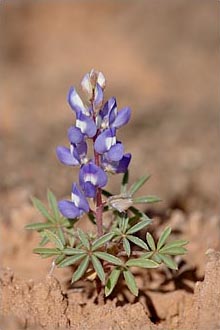
Photographed Without A Diffuser
(Needles District), Utah, USA
1/750 sec, f5.6, ISO 100
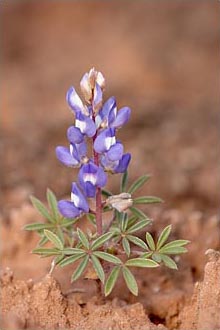
Photographed With A Diffuser
(Needles District), Utah, USA
1/125 sec, f5.6, ISO 100
Travel: Goblin Valley State Park, Utah
We spent four nights in early May near Goblin Valley State Park, Utah. It was our first time there, and we want to go back! The goblins are small hoodoos eroded from the same entrada sandstone as in Arches National Park, and we had lots of fun exploring the valleys that are filled with them. The weather wasn't too good for photography though. It was clear the first day we photographed there (below left), but I had a ball using my new Canon TS-E 24mm f3.5 L II (24 TS II). To take the image, I used the tilt motion to align the plane of focus with the top of the near boulder and the top of the formations in the center of the image. With f11, the ground in the foreground, the top of the formation in the upper left, and the formation in the distance in the middle right are all in focus. The image could have been taken without using the shift motion, but then f22 or f32 would be required, and the image would have been softer throughout due to diffraction. The second day we went into the park It was mostly cloudy, with mostly boring clouds, but I was able to get a nice image of a goblin with an interesting cloud (below center).
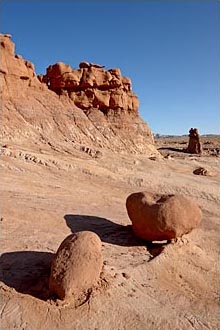
Utah, USA
1/180 sec, f11, ISO 100
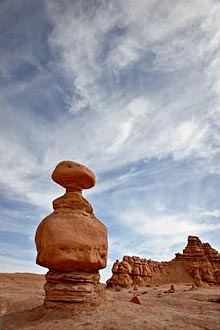
Utah, USA
24-105 (at 28mm),
1/125 & 1/60 sec, f11, ISO 100
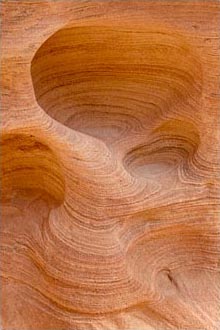
San Rafael Swell,
Utah, USA
1/45 sec, f11, ISO 100
While staying near Goblin Valley State Park, we hiked through Little Wild Horse Canyon in the San Rafael Swell. There are several narrow slots along the canyon and I really enjoyed exploring the area. Unfortunately, most of the canyon isn't very photogenic on a grand scale. However, there were many opportunities for photography on a smaller scale including the interesting layered sandstone that was worn into several small pockets on the side of the canyon (above right). Here, I used the tilt motion of the 90 TS to align the plane of focus along the average of the wavy surface.
Travel: Arches National Park, Utah
We spent eight nights boondocking near Arches National Park in mid May. We timed our visit for the wildflower bloom, and I think we hit the peak! We even had some nice clouds one day, and the combination of blue sky, white clouds, red rocks, and colorful wildflowers was fantastic (below left and center)! I used my new 24 TS II for both images, and in addition to using the tilt function to align the plane of focus with the foreground and background, I also used the shift function to "look up" at the rock formations without tilting the camera up which let me have a more natural look to the formations instead of having them appear to be falling over backwards due to keystoning.
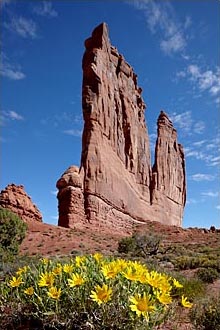
Rough Mulesears
1/60 sec, f16, ISO 100
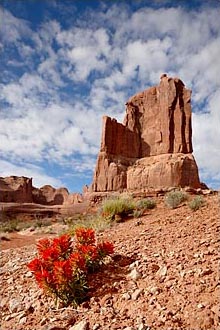
Common Paintbrush
1/125 sec, f11, ISO 100
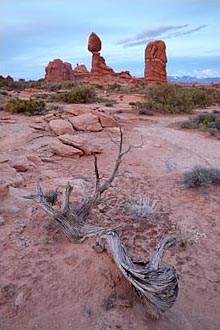
3 stops graduated ND,
1.5 sec, f11, ISO 100
We didn't have any great sunsets, but I was able to work with what we had one evening to capture a nice image of Balanced Rock with a worn juniper trunk in the foreground. While it's not as colorful as the previous two images, I just love the pastel colors and the many layers in the image. The small image in this Newsletter doesn't do it justice. Once again, I used my new 24 TS II with the tilt function to align the plane of focus with the foreground and background and I used just a little of the shift function to reduce keystoning. I also used three stops of graduated neutral density to help balance the exposure between the bright sky and the dark foreground.
We also focused our attention on just the flowers that were blooming. The Dwarf Evening-Primrose (below left) is interesting because the flowers bloom white and turn pink after they're pollinated. The Stevia Dusty-Maiden in the image below right wasn't in full bloom yet, but I liked the flower head as it was developing.
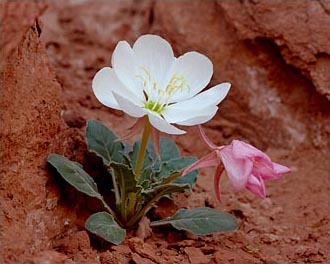
1/4 sec, f11, ISO 100
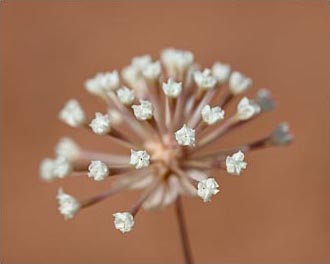
1/500 sec, f5.6, ISO 100
Travel: Canyonlands National Park (Needles District), Utah
Then we went to the Needles District of Canyonlands National Park in mid May and boondocked nearby for five nights. We went primarily to photograph some Claretcup Cactus which bloom with a fantastic red flower with a yellow/green pistil (below left). While photographing them one morning, I also turned my attention to the Anderson's Larkspur blooming nearby (below center). One of my favorite images of our stay there is of a Prairie Wild Onion with a spiraling part of its stem (below right).
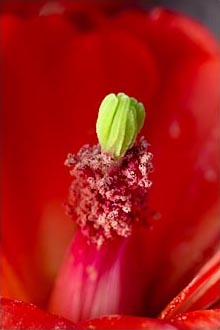
(Needles District), Utah, USA
1/20 sec, f8, ISO 100
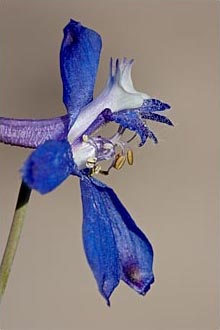
(Needles District), Utah, USA
1/30 sec, f16, ISO 100
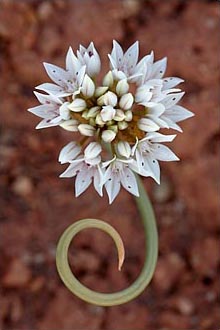
(Needles District), Utah, USA
1/6 sec, f8, ISO 100
One evening, we found a very cooperative Colorado Side-Blotched Lizard (below left) on a short exploratory drive near our boondocking spot. Also that evening, we found some great Dwarf Lupine on some nice smooth sandy ground. The sun had just set when I took the image, so I was fortunate to have some great naturally-diffuse light for the image.
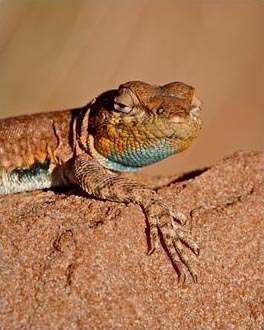
(Needles District), Utah, USA
1/125 sec, f22, ISO 400
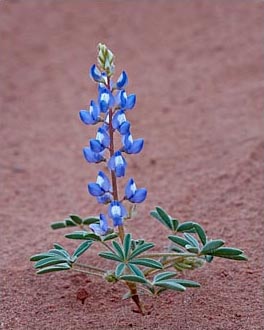
(Needles District), Utah, USA
3 sec, f11, ISO 100
Travel: Swift Foxes in the Pawnee National Grassland, Colorado
We had a wonderful time with a group of Swift Foxes in the Pawnee National Grassland in northeastern Colorado. We spent seven nights in the Pawnee at the end of May and six nights there in mid June. When we first arrived in May, we looked at the den where we had photographed Swift Foxes in 2007. It didn't look active, so we looked elsewhere for an active den with kits. We spent two days driving around the grassland before we found a Swift Fox. That's not unusual because they're small and blend in with the tall, dry grass. It was an adult with no signs of kits, so we kept looking. We found a second Swift Fox at another den later that day, but still no signs of kits. While walking around near our boondocking spot to check out a den that looked like a backup in 2007, I practically walked over a Swift Fox near the den where we photographed them in 2007! As I searched the area, I found lots of inactive dens in the area, so maybe it was one of those that I had checked on our first day this time. We set up our blind near the active den and had a blast photographing the Swift Fox vixen and four kits! The kits are just so cute (below left)! We saw lots of affectionate interaction between the kits and the vixen, like in the image below right.
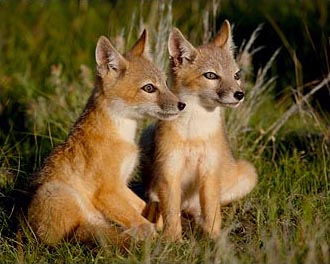
1/1000 sec, f9.5, ISO 400
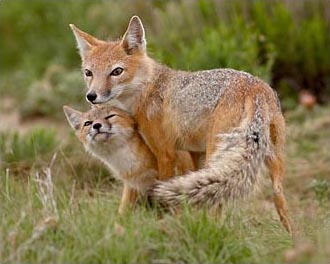
1/500 sec, f8, ISO 640
The vixen was a good mother, and we watched her nurse on several occasions. She would either sit up or stand, and the kits would climb under her to get fed (below left). She was also very patient as the kits climbed all over her or even playfully bit her ear (below right).
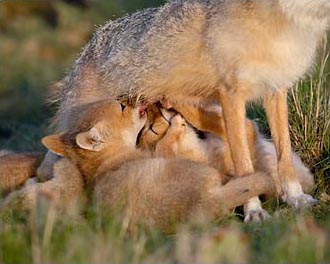
1/500 sec, f8, ISO 640
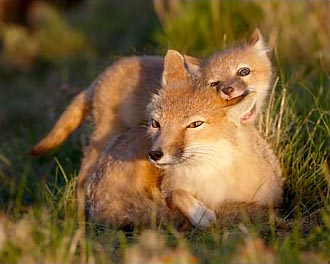
1/500 sec, f8, ISO 640
Swift Foxes are smaller than Red Foxes, and the kits reminded me of cats by the way they played with each other. They would stalk their opponent and then pounce just like a cat. And, even when they were running around chasing each other, their footsteps didn't make a sound.
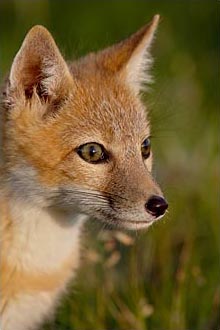
Colorado, USA
1/500 sec, f8, ISO 250

Colorado, USA
1/750 sec, f8, ISO 500
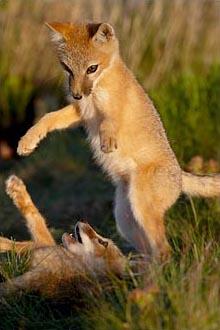
Colorado, USA
1/350 sec, f9.5, ISO 400
Take care and happy shooting.
— James
James Hager Photography :: www.jameshagerphoto.com




